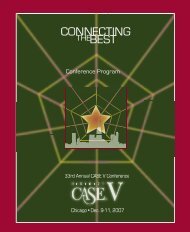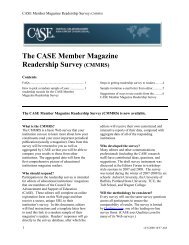You also want an ePaper? Increase the reach of your titles
YUMPU automatically turns print PDFs into web optimized ePapers that Google loves.
letters<br />
To Our Letter Writers<br />
The Bulletin welcomes letters of 300 or fewer<br />
words. Letters to the editor may be used for<br />
publication unless the author states the letter<br />
is not to be published. Letters may be edited for<br />
style, length, clarity, grammar, and relevance to<br />
<strong>Kenyon</strong> issues. Please address submissions to :<br />
Editor, <strong>Kenyon</strong> <strong>College</strong> Alumni Bulletin, Office of<br />
Public Affairs, Gambier, Ohio 43022. Letters may<br />
also be submitted to alumni@kenyon.edu.<br />
Photographic blunder<br />
Your fall 2011 cover story (“Jubilant Jump”) celebrated<br />
the success of the $240 million “We Are<br />
<strong>Kenyon</strong>” campaign. The moment was captured<br />
with a photo of eleven ecstatic students cheering<br />
on the steps of Rosse Hall. As one of <strong>Kenyon</strong>’s<br />
proud African-American alumni, I was hurt,<br />
embarrassed, and angry when I noticed that<br />
none of the celebrants was a person of color. The<br />
<strong>College</strong> is reportedly much more diverse today<br />
than when I graduated in 1983. One wouldn’t<br />
know from the cover photo. “We Are <strong>Kenyon</strong>”<br />
refers to whom? A little forethought could have<br />
avoided this photographic PR blunder. <strong>Kenyon</strong><br />
deserves better.<br />
—Jeremy V. Johnson ’83<br />
An iffy question<br />
In the Fall 2011 Bulletin (Letters), Megan B.<br />
Pomeroy ’90 corrected an error regarding “if<br />
<strong>Kenyon</strong> wasn’t” versus “if <strong>Kenyon</strong> weren’t.”<br />
However, she mistakenly said that the word if<br />
“always takes the subjunctive.” This applies only<br />
when the statement is contrary to fact: “If I were<br />
the editor of the Alumni Bulletin, I would have<br />
caught that error.” However, there are many<br />
cases where “if” can be used with statements<br />
that may or may not be true, and in those cases<br />
“was” is appropriate: “If I was overstepping my<br />
bounds in pointing out this additional error,<br />
then I am sorry.”<br />
—Joe Stollenwerk ’95<br />
A sentence beginning with “if” takes the<br />
subjunctive only for conditions contrary to<br />
fact. For conditions that exist or may exist, the<br />
subjunctive should not be used. “You wouldn’t<br />
be reading this magazine if <strong>Kenyon</strong> wasn’t<br />
special to you” is entirely correct: it is a safe<br />
assumption that readers of this magazine have<br />
special feelings for <strong>Kenyon</strong>.<br />
—Julie Kuzneski Wrinn (married to Steve<br />
Wrinn ’91)<br />
Tattoo traditions<br />
I was troubled by the letters in the last Bulletin<br />
variously referring to the tattoos of <strong>Kenyon</strong><br />
students as “depraved,” “disreputable,” and acts<br />
of “debasement,” and suggesting that tattoos are<br />
“hallmarks of gangs and criminals” and indicative<br />
of “psychopathy.”<br />
The fact is that tattoos no longer carry the<br />
stigma they did for earlier generations. As a<br />
student at a prominent law school, I found<br />
that tattoos were common among my peers.<br />
At the Silicon Valley law firm where I represented<br />
startups and tech giants, tattoos could<br />
be spotted beneath the business casual attire<br />
of my colleagues and clients. And now as a law<br />
professor, I note that both students and faculty<br />
members, like me, are among the growing ranks<br />
of the tattooed. Very few of us, I assure you, are<br />
gang members, criminals, or psychopaths.<br />
The history of tattoos did not start with<br />
Hitler and end with the Hells Angels. This<br />
culturally blinkered account neglects rich traditions<br />
outside of our own. The word “tattoo”<br />
entered our language after Captain Cook’s<br />
voyage to Tahiti, where the locals had practiced<br />
the art for generations. After Cook’s return<br />
to England, something of a trend emerged in<br />
British high society, with no less than Edward<br />
VII and George V embracing the art form. That<br />
is to say nothing of Japanese tattooing, which<br />
dates back to the paleolithic era. Humility<br />
suggests we hesitate before dismissing a practice<br />
that emerged and thrived independently across<br />
these diverse cultures.<br />
—Aaron Perzanowski ’01<br />
Memories and joy<br />
Every issue of the Bulletin brings great memories<br />
of the past and joy at the present and future!<br />
Thank you very much.<br />
—John L. McKenney ’48<br />
editor’s note: We are happy to know that we<br />
didn’t go grammatically astray. But we still<br />
appreciate Ms. Pomeroy’s reminder to write with<br />
care. And, of course, we do hope that <strong>Kenyon</strong> is<br />
special to our readers.
















